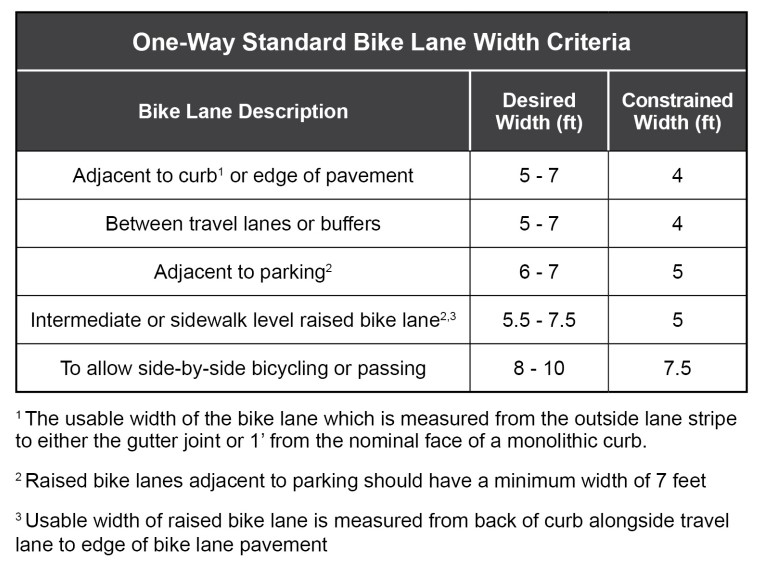18.4.4 Bike Lanes

Figure 18-22: Example Bike Lane Schematic
Bike lanes are one-way facilities on a roadway that typically carry bicycle traffic in the same direction as adjacent motor vehicle traffic. Bike lanes are provided for the exclusive use of bicyclists and are identified through signage, striping, or other pavement markings. These lanes allow bicyclists to ride at comfortable speeds and encourage a position within the roadway where they are more likely to be seen by motorists. Bike lanes are typically on the right side of the street, between the outside travel lane and curb, parking lane, or road edge. While the bike lane distinguishes predictable areas for bicyclist and automobile movement, bicyclists may leave the bikeway to pass other bicyclists or avoid debris and other traffic conflicts.
18.4.4.1 Application
Bike lanes should only be used in locations with speeds of 45 mph or less. For high-speed locations, a buffered bike lane is recommended.
In locations where space allows and additional protection and conspicuity is desired, designers may consider a raised bike lane, see
. This can be particularly beneficial at intersections, see
.
18.4.4.2 Width
The width of a bike lane has a significant impact on a bicyclists’ comfort and their central operating position within a bike lane. See
for one-way standard bike lane width criteria. As the adjacent motorized traffic volume and speed increases, or as the relative percent of heavy vehicles increases, bicyclists will try to move away from vehicles operating in the adjacent travel lane, positioning themselves closer to parked vehicles or the edge of roadway which can increase their crash risk.
Table 18-13: One-Way Standard Bike Lane Width Criteria

18.4.4.3 Signing and Marking
A solid white edge line (6-in wide) should be placed between the bike lane and travel lane. Lane lines between parked cars and the bike lane are optional.
Standard bike lane symbols and arrows, per the
, should be used to inform bicyclists and motorists of the restricted nature of the bike lane, and markings should be placed at periodic intervals to remind motorists of the presence of bicyclists.
Bike lane symbol markings should be placed no more than 50-ft downstream from an intersection. The first marking after an intersection or driveway should be placed outside of the wheel path of turning vehicles to reduce wear:
- In urban areas, it may be appropriate to space the symbols closer than 250-ft where motorist conflicts may be higher such as approaches to areas with significant parking turnover, intersections, driveways, or turn lanes; and
- In suburban and rural areas, with long distances between intersections and little roadside activity, bike lane symbols may be spaced 1,000-ft apart or more.
18.4.4.4 Bicycle Design Speed
Not applicable as the roadway will be designed to accommodate motorist target design speeds which will exceed bicyclists.
18.4.4.5 Cross Slope and Grade
Not applicable.
18.4.4.6 Other Considerations
The effective width of a bike lane should not include rumble strips or standard drainage inlets.
Drainage grates located in the bike lane should be designed to prevent bicycle tires from catching in the grate pattern. See
for more information on drainage inlet grates in bicycle facilities